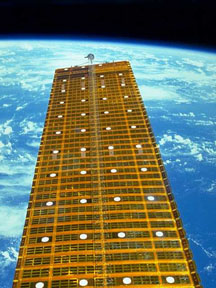






|
Solar cells work by converting the energy of the Sun's light into electricity to power spacecraft systems. They depend on semiconductor materials which are very sensitive to damage by high speed solar particles. During normal operation, light from the Sun is absorbed by the material in the solar cell and kicks electrons out of the crystal array of the semiconductor. The flow of these electrons produces the currents used to power devices in the spacecraft. However, during major solar particle events, high speed ions smash into the semiconductor material liberating electrons from the crystal array. They degrade the semiconductor material and reduce the expected lifetime over which the solar cells will be able to produce energy for the spacecraft. For example in October 1989, solar panels on a GOES satellite were degraded so badly that they lost 6-years of operating lifetime during a single (several day long) solar proton event. A similar event in March 1990, produced a 3-year loss of operating lifetime in spacecraft solar panels. |